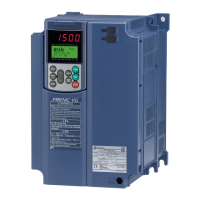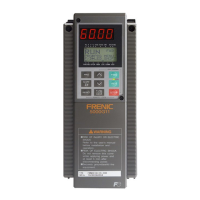5-123
Application example: Process control (for air conditioners, fans and pumps)
The operating range for PID process control is internally controlled as 0% through 100%. For the given feedback input,
determine the operating range to be controlled by means of gain adjustment.
Example: When the output level of the external sensor is within the range of 1 to 5 V:
• Use terminal [12] since the connection terminal is for voltage input.
• Set the gain (C32 for analog input adjustment) at 200% in order to make the maximum value (5 V) of the external
sensor's output correspond to 100%. Note that the input specification for terminal [12] is 0 to 10 V corresponding to 0
to 100%; thus, a gain factor of 200% (= 10 V ÷ 5 V × 100) should be specified. Note also that any bias setting does
not apply to feedback control.
Application examples: Dancer control
(for winders)
Example 1. When the output level of the external sensor is ±7 VDC:
• Use terminal [12] since the voltage input is of bipolar.
• When the external sensor's output is of bipolar, the inverter controls the speed within the range of ±100%. To convert
the output ±7 VDC to ±100%, set the gain (C32 for analog input adjustment) at 143% as calculated below.
10 V
7 V
≈ 143%
Example 2. When the output level of the external sensor is 0 to 10 VDC:
• Use terminal [12] since the connection terminal is for voltage input.
• When the external sensor's output is of unipolar, the inverter controls the speed within the range of 0 to 100%.
In this example, it is recommended that the dancer reference position be set around the +5 V (50%) point.
PID Display Coefficient and Monitoring
To monitor the PID command and its feedback value, set the display coefficient to convert the values into
easy-to-understand mnemonic physical quantities, such as temperature.
Refer to function codes E40 and E41 for details on display coefficients, and to E43 for details on monitoring.

